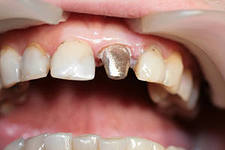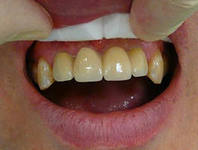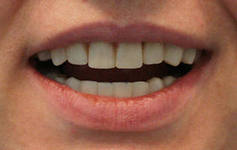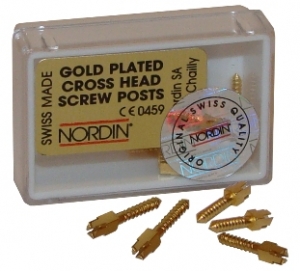Pins

The pin in the tooth is a support for fixed or removable dentures.
A pin is a shaft-like design that serves to strengthen a decayed tooth and is fixed in the root canals.
Installation of the structure may be necessary in case of severe tooth decay, when the only way to restore them is to extend the teeth on the pin.
The teeth restored with the help of pins are called pins.
What are pins made of?
Dental pins can be made of:
- metal
- non-metallic materials
Metals used to make metal pins:
- Titanium
- Stainless steel
- Brass
- Gold alloys with impurities
- Palladium
Non-metallic materials:
- Fiberglass
- Carbon fiber
- Ceramics
What are the pins for teeth
Modern dentistry offers various types of pins. They are diverse in form, manner of fixation and composition.
- A standard tooth pin may have a conical or cylindrical shape. Such pins are used when teeth

Photo: anchor pin destroyed slightly. The shaft is adjusted to the root of the tooth with special tools.
- A metal rod is used, if necessary, to restore a badly damaged tooth. The titanium pin in the tooth well strengthens the restored part of the tooth.
- Fiberglass pins. Fiberglass has elasticity, does not react with dentures and saliva. Do not shine through the seal or crown. Fiberglass rods successfully replace metal pins.
- Carbon fiber rods are one of the most modern types of pins. They are the most durable, evenly distribute the load inside the root canal. The use of such pins provides the maximum therapeutic effect.
- Anchor rods are made of titanium alloy. Tooth restoration using a titanium pin is one of the best types of tooth restoration today.
- Individual pins - rods are made taking into account the relief of a particular root. They are more reliable than standard pins, as well held in the hopeless root canals of the teeth.
According to the shape of the root canal of the tooth, the pins can be:

- Conical
- Cylindrical
- Cylindrical
- Screw
According to the fixing method, the pins are divided into:
- The active dental pin is a solid shaft that is fixed in the dentin. This is one of the reliable mounts. The pin has a thread by which it is screwed into the bone tissue. This type of pin is used when it is necessary to restore an almost completely destroyed tooth. When using an active pin, additional stress is created, which can cause a tooth split.
- The passive pin is fixed in the cavity of the root canal using a special substance.Such a pin is used if tooth strengthening after treatment is required.
What to consider when choosing
The pins are used to restore the tooth or attach to the root of the denture or crown.
Depending on the degree of tooth decay, wishes and financial possibilities of the patient, this or that pin design is chosen. In any situation, the choice of the type of punching is up to the specialist.
Moreover, only the doctor who practices as a therapist and as an orthopedist can choose the most suitable design.
When choosing a pin for the patient, the doctor should consider the following:
- The degree of destruction of the tooth root, the thickness of its walls. How deep can I put the pin.
- How badly the tooth collapsed, at what level with respect to the gum root destruction occurred.
- The load on the tooth after its restoration. Is a tooth freestanding or supporting for a bridge or removable structure.
- The choice of material, taking into account the health of the patient and the possibility of necessary actions for the restoration of teeth.
In recent years, the use of non-metallic rods is more in demand, due to their more convenient use. For example, tooth restoration with a fiberglass pin allows you to perfectly and firmly fill the root canal of the tooth.
If it is supposed to create an extended tooth on a pin without using a crown, then the use of a fiberglass rod will be most preferable, This material has a more natural color and interacts well with filling materials.
Indications for the installation of the pin
- Restoration of teeth with more than half tooth coronary fracture.
- Complete absence of a dental crown.
- To create support when installing removable and fixed prostheses.
Contraindications

- Complete absence of a tooth crown in the anterior region.
- Blood disease.
- Diseases of the nervous system
- The presence of periodontal damage.
- Inflammatory periodontal disease.
- Caries.
- Cysts, granulomas of the oral cavity.
- When the root length is less than the planned height of the tooth crown.
- The wall thickness of the root is less than 2 mm.
Pros and cons of pins
Advantages of using pins:
- The possibility of restoration of a damaged tooth.
- The use of rods for tooth restoration from a fiberglass pin reduces the likelihood of fracture of their roots.
- The aesthetics of the fiberglass pins allow them to be used to restore the front teeth.
- The elasticity of the carbon fiber pins allows you to evenly distribute the voltage in the root canal of the tooth, which ensures high strength of the shaft.
- The use of pins allows you to avoid tooth extraction, and also helps to restore its functionality.
- The service life of a pin design made of cermet is more than ten years.
Disadvantages of using structures:
- The pins can cause tooth decay.
- The development of caries - with poor-quality installation of the pin.
- The disadvantage of some materials used for pins in the absence of their flexibility.
- Metal pin structures corrode when interacting with the root canal, with fluids, saliva.
- Insufficient connection to the root of the tooth metal rods.
- The presence of certain difficulties in the removal of pins made of certain materials. In this case, the pins must be removed together with the tooth root.
- An allergic reaction can cause pin rejection or a strong local reaction.
- Over time, the walls of the tooth can become very thin, which can lead to its further destruction and the impossibility of re-restoration.
- The teeth on the pins are quite expensive. The price depends on the material from which the structures are made.
How to install the pin in the tooth. Tooth restoration
When using a standard pin, the root of the tooth is adjusted under the shaft using special tools.Sometimes sets of pins are additionally equipped with tools for their installation. If the kits do not have tools for installing pins, then the doctor uses dental instruments. This approach to work can lead to an inaccurate landing of the rod in the root canal.
The installation of the pin and the restoration of a damaged or lost tooth takes place in several stages:
- The root canal is cleared.
- A rod is inserted into the canal so that it enters the bone. This, in turn, allows you to strengthen the root of the tooth and is necessary for better fixation of the pin.
- Fixation of the structure with filling material.
- Prosthetics: either put a crown on a part of a tooth with a pin, if it is missing, install an artificial tooth on the pin.
- Checking the fastening of the crown on the pin. It is carried out in a day. Based on his feelings, the patient determines whether a new design interferes with him. If necessary, grinding is carried out.
Video: Toothpins
Rehabilitation and recovery
In order for tooth restoration to be successful, you must follow the doctor's recommendations after installing the pins.
- Take medications prescribed by your doctor, follow a diet.
- Food should be soft, mashed and liquid. It should not injure the mucous membrane of the oral cavity.
- To prevent inflammation in the oral cavity, thorough hygienic care is necessary. Teeth should be brushed at least twice a day, being careful not to injure the gums. After cleaning, rinse your mouth thoroughly with water.
- It is strictly forbidden to use toothpicks, especially in the field of tooth restoration. It is recommended to use dental floss to clean the contact surfaces of the teeth.
- In no case do not try to open the bottle with your teeth, gnaw seeds and nuts.
- A dentist should be visited by a doctor at least once every 6 months.
Complications after installing the pin, the consequences
- Pain
- Swelling and gum disease.
- Periodontitis
- If oral hygiene is not observed, inflammation of the surrounding tissues may occur.
Tooth ache with a pin
- After the patient has installed the pin, it often seems that the tooth on the pin hurts. This is due to the fact that in the process of tooth restoration soft tissues are affected. Pain can be caused by a deep entry of the rod into the root canal.
- If a tooth with a pin hurts immediately after removal of the nerve, then this is natural and painful sensations will persist for several days. The pain should decrease every day. If, on the contrary, it intensifies, it is urgent to consult a doctor.
- Pain can occur as a result of an allergic reaction to the material from which the pin is made. In this case, the pain is combined with such manifestations of allergies as hyperemia, stomatitis and worsening of well-being.
- In any case, if you put the pin, and the tooth hurts, do not cancel the visit to the dentist. He will conduct an examination, if necessary, take an x-ray, explain the causes of pain.
Analogs
Standard pins have the following analogues:

- Stump cast tabs. Cast pin designs are monoblocks and are made of the same material. Twenty years ago, these designs were used to restore the crown-root sections of teeth. At the moment, they were replaced by standard pins.
- Luminex technology, which combines the benefits of standard pin designs and stump molded inlays. In this case, standard pins made of titanium and light guides - analogues are used.
- Creating a stump without pins.
- Individual pins - stump tabs are more reliable than standard pin designs, which have sufficient ability to be fixed in almost hopeless roots.
- Collapsible individual pin designs.They are installed on badly damaged chewing teeth, which, after restoration, can carry a significant load.
Prices for installing a pin in a tooth
| Tooth pin | Cost |
| Anchor pin | 400 rubles |
| Metal pin | 600 rubles |
| Fiberglass pin | 700 rubles |
FAQ
- Question: Does it hurt to put a pin in a tooth?
Answer: No, it doesn’t hurt. Before installing the pin, the tooth nerve is removed (depulpated). And when there is no pulp (nerve), then there is no pain.
- Question: Can a pin in a tooth give an allergic reaction?
Answer: Yes, the pins can cause an allergic reaction.
- Question: What should I do if the pin breaks?
Answer: Do not take any measures yourself. It is necessary to contact a dental clinic. Only a specialist can solve this problem.
- Question: What should I do if I swallow a tooth with a pin?
Answer: If a foreign body is swallowed, consult a surgeon. He will schedule an X-ray and decide what to do next.
- Question: How is a pin inserted in a tooth?
Answer: A pin is screwed into the root canal and a seal is built on top. If necessary, prosthetics are performed.
- Question: How much do false teeth on pins cost?
Answer: The price depends on the material from which the pin and crowns are made.
Tooth pin reviews
- My pins are 18 years old and have never had any problems. 10 years ago I put a seal with modern material and everything is still fine. The pin in the tooth is visible on the left, but since it is on the upper jaw - it is invisible. About six years ago, the color of these teeth changed a little. ( Helena)
- Eight months ago, two pins were placed on the front teeth from above, as well as ceramic crowns. The teeth hurt all eight months and there is a burning sensation of the gums. (Tatyana)
- 15 years ago, a metal pin for a ceramic-metal crown was placed in my front tooth. So far, no problems have arisen. (Evgeny)
- 6 months ago they put a pin on me and sealed it with a photopolymer seal. Since the seal interfered with me, they turned it. As a result, a speck appeared on the tooth, and then a taste of metal in the mouth. (Sergei)
Photos before and after installing the pin
 |
 |
 |
 |
 |
 |



